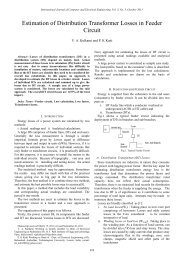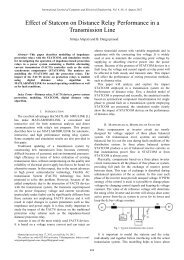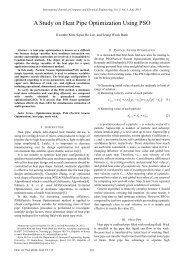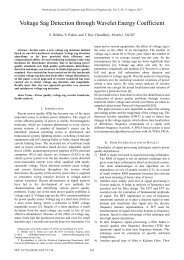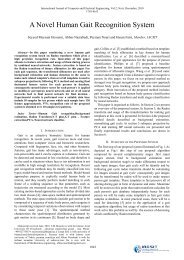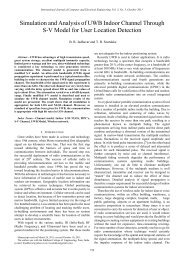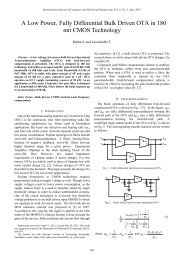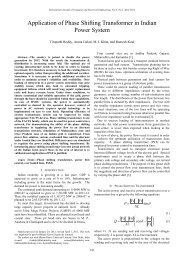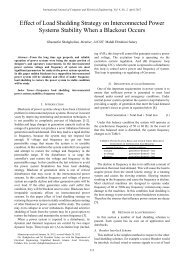Adaptive Particle Swarm Optimization for the Design of Three ... - ijcee
Adaptive Particle Swarm Optimization for the Design of Three ... - ijcee
Adaptive Particle Swarm Optimization for the Design of Three ... - ijcee
You also want an ePaper? Increase the reach of your titles
YUMPU automatically turns print PDFs into web optimized ePapers that Google loves.
International Journal <strong>of</strong> Computer and Electrical Engineering, Vol. 2, No. 4, August, 2010<br />
1793-8163<br />
<strong>Adaptive</strong> <strong>Particle</strong> <strong>Swarm</strong> <strong>Optimization</strong> <strong>for</strong> <strong>the</strong><br />
<strong>Design</strong> <strong>of</strong> <strong>Three</strong>-Phase Induction Motor<br />
Considering <strong>the</strong> Active Power Loss Effect<br />
V.P. Sakthivel, R. Bhuvaneswari and S. Subramanian, Senior Member, IEEE<br />
Abstract—The paper presents an effective evolutionary<br />
method to <strong>the</strong> optimum design <strong>of</strong> three-phase induction motor<br />
using adaptive particle swarm optimization (APSO) technique.<br />
To avoid premature convergence <strong>of</strong> <strong>the</strong> classical PSO algorithm,<br />
<strong>the</strong> parameters such as inertia weight factor and acceleration<br />
factors are made adaptive on <strong>the</strong> basis <strong>of</strong> objective functions <strong>of</strong><br />
<strong>the</strong> current and best solutions. The optimization algorithm<br />
considers <strong>the</strong> annual cost <strong>of</strong> <strong>the</strong> motor including <strong>the</strong> power loss<br />
cost as objective function and six important motor per<strong>for</strong>mance<br />
indices as inequality constraints. These functions are expressed<br />
in terms <strong>of</strong> motor design variables. The APSO integrates<br />
penalty parameter-less constraint handling strategy <strong>for</strong><br />
handling <strong>the</strong> constraints. The potential <strong>of</strong> <strong>the</strong> proposed<br />
approach has been tested on two sample motors, and <strong>the</strong> results<br />
are compared with genetic algorithm, classical PSO and<br />
conventional design methods. It is observed that <strong>the</strong> proposed<br />
method is superior in terms <strong>of</strong> solution quality, robustness and<br />
computational efficiency.<br />
Index Terms— <strong>Adaptive</strong> particle swarm optimization,<br />
genetic algorithm, Induction motor, optimal design, particle<br />
swarm optimization.<br />
I. INTRODUCTION<br />
Minimal energy consumption <strong>of</strong> three-phase induction<br />
motors is one <strong>of</strong> <strong>the</strong> important factors <strong>for</strong> energy savings<br />
because <strong>of</strong> <strong>the</strong> number <strong>of</strong> three-phase induction motors<br />
in-service are more. Due to <strong>the</strong> massive fabrication and usage<br />
<strong>of</strong> <strong>the</strong> induction motor, its manufacturer and operating cost<br />
should be minimized. The objective <strong>of</strong> <strong>the</strong> optimal design <strong>of</strong><br />
induction motor is usually to minimize ei<strong>the</strong>r <strong>the</strong> initial cost<br />
<strong>of</strong> <strong>the</strong> machine or its life time cost including <strong>the</strong> cost <strong>of</strong> loss<br />
energy. The initial (manufacturer) cost minimization is <strong>the</strong><br />
primary interest <strong>of</strong> <strong>the</strong> motor manufacturer but may not be<br />
benefit to <strong>the</strong> users. Because <strong>the</strong> manufacturer cost is a small<br />
portion <strong>of</strong> <strong>the</strong> total power loss cost <strong>of</strong> <strong>the</strong> motor during its life<br />
time. There<strong>for</strong>e, active power loss effect should also be<br />
included in <strong>the</strong> design <strong>of</strong> induction motor. This objective is<br />
Manuscript received November 10, 2009.<br />
V.P.Sakthivel is with <strong>the</strong> Department <strong>of</strong> Electrical Engineering,<br />
Annamalai University, Annamalai Nagar, Chidambaram-608002, Tamilnadu<br />
(e-mail:vp.sakthivel@yahoo.com).<br />
R.Bhuveneswari is with <strong>the</strong> Department <strong>of</strong> Electrical Engineering,<br />
Annamalai University, Chidambaram-608002, India (e-mail:<br />
boonisridhar@rediffmail.com).<br />
S.Subramanian is with <strong>the</strong> Department <strong>of</strong> Electrical Engineering,<br />
Annamalai University, Chidambaram-608002, India (e-mail:<br />
pr<strong>of</strong>drmani@gmailcom).<br />
627<br />
<strong>the</strong> main consideration <strong>for</strong> <strong>the</strong> motor user as <strong>the</strong> life time cost<br />
is reduced and also results to <strong>the</strong> admirable goal <strong>of</strong> global<br />
energy conservation.<br />
The optimization <strong>of</strong> induction motor design has been<br />
approached as a multi variable nonlinear programming<br />
problem using various conventional local optimization<br />
methods [1-10]. However, <strong>the</strong> occurrence <strong>of</strong> undesired local<br />
minima was pointed out in several works [2-4].<br />
For satisfactory handling <strong>of</strong> induction motor design<br />
optimization problems, efficient approaches are still required.<br />
The methods that qualify are evolutionary algorithm [11],<br />
GA [12], neural network [13], fully logic [14] and particle<br />
swarm optimization [15]. These heuristic approaches suffer<br />
from <strong>the</strong> problem <strong>of</strong> premature convergence. Though<br />
GA-based approaches per<strong>for</strong>m well <strong>for</strong> complex<br />
optimization problems, recent research has identified certain<br />
deficiencies [16], particularly <strong>for</strong> problems in which<br />
variables are highly correlated. In such cases, <strong>the</strong> GA<br />
crossover and mutation operators do not generate individuals<br />
with better fitness <strong>of</strong> <strong>of</strong>fspring as <strong>the</strong> chromosomes in <strong>the</strong><br />
population pool have some structure towards <strong>the</strong> end <strong>of</strong> <strong>the</strong><br />
search. Premature convergence degrades <strong>the</strong> per<strong>for</strong>mance <strong>of</strong><br />
GA and increases possibility <strong>of</strong> convergence to a local<br />
optimum solution.<br />
The PSO, first introduced by Kennedy and Eberhart [17] is<br />
a flexible, robust, population based stochastic<br />
search/optimization algorithm with inherent parallelism. In<br />
recent years this method has gained popularity over its<br />
competitors and is increasingly gaining acceptance <strong>for</strong><br />
solving many power system problems [18-20], due to its<br />
simplicity, superior convergence characteristics and high<br />
solution quality. However, <strong>the</strong> per<strong>for</strong>mance <strong>of</strong> <strong>the</strong> classical<br />
PSO greatly depends on its parameters and it <strong>of</strong>ten suffers<br />
from <strong>the</strong> problem <strong>of</strong> being trapped in local optima [21-23].<br />
To overcome <strong>the</strong> above problems, adaptive PSO<br />
parameters are employed in this paper <strong>for</strong> solving <strong>the</strong><br />
induction motor design optimization problem considering <strong>the</strong><br />
active power loss effect. Finally, <strong>the</strong> APSO algorithm is<br />
tested on two sample motors and compared with <strong>the</strong> classical<br />
PSO and <strong>the</strong> conventional design methods [24-25]. The<br />
objectives <strong>of</strong> this paper are as follows:<br />
1) To optimize <strong>the</strong> design variables <strong>of</strong> <strong>the</strong> induction motor,<br />
its total annual cost is chosen as objective function. The<br />
total annual cost is considered to be summation <strong>of</strong><br />
i. annual cost <strong>of</strong> <strong>the</strong> motor manufactured iron and<br />
copper materials,
International Journal <strong>of</strong> Computer and Electrical Engineering, Vol. 2, No. 4, August, 2010<br />
1793-8163<br />
ii. annual cost <strong>of</strong> a fictitious active power source<br />
required to cover <strong>the</strong> total active power loss <strong>of</strong> <strong>the</strong><br />
motor and<br />
iii. annual cost <strong>of</strong> energy needed by that fictitious<br />
source.<br />
2) To avoid premature convergence, <strong>the</strong> inertia weight<br />
factor and <strong>the</strong> acceleration factors are made adaptive.<br />
3) To handle <strong>the</strong> constraints effectively, <strong>the</strong> penalty<br />
parameter-less approach is used.<br />
II. FORMULATION OF AN INDUCTION MOTOR DESIGN<br />
PROBLEM<br />
The problem in <strong>the</strong> induction motor design is to select an<br />
appropriate combination <strong>of</strong> <strong>the</strong> design variables which<br />
minimize <strong>the</strong> annual cost <strong>of</strong> <strong>the</strong> motor. The design problem<br />
would have been much complicated while using too many<br />
variables. There<strong>for</strong>e <strong>the</strong> design variables selection is<br />
important in <strong>the</strong> motor design optimization. The design has<br />
some constraints to guarantee <strong>the</strong> some motor per<strong>for</strong>mance<br />
indices. The design optimization problem can be <strong>for</strong>mulated<br />
as a general nonlinear programming problem <strong>of</strong> <strong>the</strong> standard<br />
<strong>for</strong>m:<br />
Find X(x1, x2, …….., xn) such that J(X) is a minimum<br />
Subject to<br />
gj(X) ≥ 0 j = 1, 2, ……… m<br />
and<br />
xLi ≤ xi ≤ xUi i = 1,2, …………n<br />
where X(x1, x2, …….., xn) is <strong>the</strong> set <strong>of</strong> independent design<br />
variables with <strong>the</strong>ir lower and upper limits as xLi and xUi, <strong>for</strong><br />
all ‘n’ variables. J(X) is <strong>the</strong> objective function to be<br />
optimized and gj(X) are <strong>the</strong> constraints imposed on <strong>the</strong><br />
design.<br />
A. Variables<br />
The following variables (X1, ….. X9) are considered.<br />
x1 = stator bore diameter<br />
x2 = average air gap flux density<br />
x3 = stator current density<br />
x4 = air gap length<br />
x5 = stator slot depth<br />
x6 = stator slot width<br />
x7 = stator core depth<br />
x8 = rotor slot depth<br />
x9 = rotor slot width<br />
The remaining parameters can be expressed in terms <strong>of</strong><br />
<strong>the</strong>se variables or may be treated as fixed <strong>for</strong> a particular<br />
design.<br />
B. Constraints<br />
The constraints (g1, ….. , g6) imposed into induction motor<br />
design in this paper are as follows.<br />
g1 = maximum to full-load torque ratio<br />
g2 = starting to full-load torque ratio<br />
g3 = starting to full-load current ratio<br />
g4 = full-load efficiency<br />
g5 = full-load power factor<br />
g6 = maximum temperature rise<br />
Apart from <strong>the</strong>se constraints, <strong>the</strong> lower and upper limits <strong>of</strong><br />
<strong>the</strong> design variables are included. The expression <strong>of</strong> <strong>the</strong><br />
constraint functions is as follows:<br />
(i). Maximum to full-load torque ratio<br />
2<br />
628<br />
⎡⎛<br />
R ⎞<br />
⎢⎜<br />
2<br />
S<br />
⎟<br />
fl<br />
R<br />
⎢⎜<br />
th<br />
+ +<br />
⎟<br />
⎣⎝<br />
S<br />
fl ⎠<br />
=<br />
1 ⎡ 2<br />
2R<br />
2<br />
R + R +<br />
⎢ th th<br />
⎣<br />
(ii). Starting to full-load torque ratio<br />
⎡<br />
2<br />
⎛ R<br />
2 ⎞<br />
S ⎢⎜<br />
fl<br />
R<br />
th<br />
+ ⎟ +<br />
⎢⎜<br />
S ⎟<br />
⎣⎝<br />
fl ⎠<br />
( X<br />
th<br />
(X<br />
th<br />
+<br />
+<br />
2<br />
X )<br />
2<br />
2<br />
X )<br />
2<br />
⎤<br />
⎥<br />
⎥<br />
⎦<br />
⎤<br />
g (1)<br />
g<br />
2<br />
=<br />
( R<br />
th<br />
+<br />
2<br />
R )<br />
2<br />
+<br />
(X<br />
th<br />
( X<br />
th<br />
+<br />
+<br />
2<br />
X )<br />
2<br />
2<br />
X )<br />
2<br />
(iii). Starting to full-load current ratio<br />
g<br />
2<br />
g = (3)<br />
3 S<br />
fl<br />
(iv). Full load power factor<br />
⎡<br />
⎢<br />
⎢<br />
⎢<br />
⎢<br />
⎣<br />
⎛<br />
⎜<br />
⎜<br />
⎜<br />
⎜<br />
⎝<br />
⎞⎤<br />
⎟⎥<br />
⎟⎥<br />
⎟⎥<br />
⎟<br />
⎟⎥<br />
⎠⎦<br />
⎥<br />
⎦<br />
⎤<br />
⎥<br />
⎥<br />
⎦<br />
(2)<br />
−1<br />
X<br />
th<br />
+ X<br />
2<br />
g = cos tan<br />
(4)<br />
4<br />
R<br />
2<br />
R<br />
th<br />
+<br />
S<br />
fl<br />
(v). Full load efficiency<br />
W<br />
g =<br />
5 W + Pt<br />
(5)<br />
Where, P t = P<br />
isc<br />
+ P<br />
ist<br />
+ Psc<br />
+ P<br />
b<br />
+ Per<br />
+ P<br />
f<br />
(vi). Maximum temperature rise<br />
g<br />
6<br />
where, V<br />
th<br />
=<br />
LPsc<br />
P<br />
is<br />
+<br />
L<br />
o<br />
πDo<br />
L πx<br />
1<br />
L π(Do<br />
− x<br />
1<br />
)(2 + n v )<br />
+ +<br />
(6)<br />
Csco<br />
C<br />
sci<br />
4Cscv<br />
=<br />
V<br />
ph<br />
X m<br />
X1<br />
+<br />
X m<br />
,<br />
R<br />
th<br />
=<br />
R1X<br />
m<br />
X1<br />
+<br />
X m<br />
,<br />
X<br />
th<br />
=<br />
X1X<br />
m<br />
X1<br />
+<br />
X m<br />
The equivalent circuit parameters R1, R2, X1, X2 and Xm<br />
can be found in terms <strong>of</strong> <strong>the</strong> design variables [24, 25].<br />
C. Objective function<br />
To have an optimal induction motor which is acceptable to<br />
both <strong>the</strong> manufacturer and <strong>the</strong> user, <strong>the</strong> minimization <strong>of</strong> <strong>the</strong><br />
annual cost <strong>of</strong> <strong>the</strong> motor is considered as objective function<br />
while designing <strong>the</strong> motor using optimization algorithms.<br />
The expression <strong>of</strong> <strong>the</strong> objective function, in terms <strong>of</strong> <strong>the</strong><br />
motor design variables are as follows:<br />
(i) Annual active material cost<br />
Annual iron material cost,
International Journal <strong>of</strong> Computer and Electrical Engineering, Vol. 2, No. 4, August, 2010<br />
1793-8163<br />
C<br />
i<br />
= αc<br />
i<br />
( M + M + M + M + M )<br />
isc ist irc irtt irtb<br />
Where,<br />
M<br />
isc<br />
= 0.88π × W<br />
i<br />
K<br />
i<br />
Lx<br />
7<br />
(x + 2x + x )<br />
1 5 7<br />
M<br />
ist<br />
= 0.88π × W<br />
i<br />
K<br />
i<br />
Lx<br />
5<br />
(π ( x + x ) - N x )<br />
1 5 s 6<br />
M<br />
irc<br />
= 0.88π × W<br />
i<br />
K<br />
i<br />
Ld ( D − 2x − d )<br />
rc r 8 rc<br />
M<br />
irtt<br />
= 0.88W<br />
i<br />
K<br />
i<br />
Ldrs<br />
(π ( D − d ) − N x )<br />
r rs r 9<br />
M<br />
irtb<br />
= 0.88W<br />
i<br />
K<br />
i<br />
L ( x - d ) ( π ( D - x - d ) - N x<br />
8 rs r 8 rs r 9<br />
Annual copper material cost,<br />
C c = αcc<br />
( M + M +<br />
sc b<br />
Where,<br />
Msc<br />
M )<br />
er<br />
⎡<br />
⎛ x ⎞ ⎤<br />
= W<br />
⎢ +<br />
⎜ 1<br />
cK<br />
ss x<br />
⎟<br />
5<br />
x<br />
6<br />
Ns<br />
0.0635 0.472 + L⎥<br />
⎣<br />
⎝ p ⎠ ⎦<br />
M<br />
b<br />
= 1.02WcK<br />
sr Lx<br />
9<br />
N r ( x − d )<br />
8 rs<br />
(x<br />
8<br />
− drs<br />
)<br />
Mer<br />
= 1.9WcK<br />
sr x<br />
1<br />
x<br />
9<br />
Nr<br />
K<br />
j<br />
p<br />
Annual active material cost is given by<br />
c C<br />
C m = C<br />
i<br />
+<br />
(9)<br />
(ii) Annual active power loss cost<br />
Annual iron loss cost,<br />
C<br />
ip<br />
= αcp<br />
(P<br />
isc<br />
+ P<br />
ist<br />
)<br />
(10)<br />
Where,<br />
P<br />
isc<br />
= p<br />
isc<br />
M<br />
isc<br />
P<br />
ist<br />
= p<br />
ist<br />
M<br />
ist<br />
Where, pisc and pist are <strong>the</strong> specific iron loss corresponding<br />
to Bsc and Bst respectively.<br />
Bsc and Bst are given as follows<br />
B sc =<br />
πx<br />
1<br />
x<br />
2<br />
1.76K<br />
i<br />
x<br />
7<br />
p<br />
1.5x x<br />
B =<br />
1 2<br />
st<br />
⎡ 2x<br />
5<br />
0.88K<br />
i ⎢x<br />
1<br />
+ −<br />
⎣ 3<br />
Annual copper loss cost<br />
C cp = αcp<br />
(Psc<br />
+ P<br />
b<br />
+ Per<br />
)<br />
Where,<br />
2<br />
x<br />
3<br />
ρs<br />
Msc<br />
P sc =<br />
Wc<br />
2<br />
δr<br />
ρr<br />
M<br />
b<br />
P<br />
b<br />
=<br />
P er =<br />
Wc<br />
2<br />
(δr<br />
K<br />
j<br />
) ρr<br />
KerM<br />
er<br />
Wc<br />
Ns<br />
x<br />
6<br />
Annual friction and windage loss cost,<br />
C<br />
fp<br />
= αcp<br />
P<br />
f<br />
π<br />
⎤<br />
⎥<br />
⎦<br />
)<br />
(7)<br />
(8)<br />
(11)<br />
(12)<br />
2<br />
3 ⎛ f ⎞<br />
Where, P<br />
f<br />
= 661x<br />
1<br />
L⎜<br />
⎟<br />
⎝ p ⎠<br />
The stray loss is assumed to reduce <strong>the</strong> efficiency by 0.5%,<br />
so that<br />
C sp = αcp<br />
Ps<br />
(13)<br />
Where,<br />
0.005 × W<br />
Ps<br />
=<br />
η<br />
The total annual active power loss cost is thus<br />
C p = C<br />
ip<br />
+ Ccp<br />
+ C<br />
fp<br />
+ Csp<br />
(14)<br />
629<br />
(iii) Annual energy loss cost<br />
C e =<br />
ce<br />
TCp<br />
αcp<br />
The objective function is given by<br />
J(X) = Cm<br />
+ C + C<br />
p e<br />
III. PARTICLE SWARM OPTIMIZATION<br />
(15)<br />
(16)<br />
PSO is a well known optimization method proposed by<br />
Kennedy and Eberhart [17]. It is motivated by social behavior<br />
<strong>of</strong> organisms such as fish schooling and bird flocking. In<br />
PSO, potential solutions called particles fly around in a<br />
multi-dimensional problem space. Population <strong>of</strong> particles is<br />
called swarm. Each particle in a swarm flies in <strong>the</strong> search<br />
space towards <strong>the</strong> optimum solution based on its own<br />
experience, experience <strong>of</strong> nearby particles and global best<br />
position among particles in <strong>the</strong> swarm.<br />
A. Advantages <strong>of</strong> PSO<br />
• PSO is easy to implement, and only few parameters have to<br />
be adjusted.<br />
• Unlike <strong>the</strong> GA, PSO has no evolution operators such as<br />
crossover and mutation.<br />
• In GAs, chromosomes share in<strong>for</strong>mation so that <strong>the</strong> whole<br />
population moves like one group, but in PSO, only global<br />
best particle (gbest) gives out in<strong>for</strong>mation to <strong>the</strong> o<strong>the</strong>rs. It<br />
is more robust than GAs.<br />
• PSO can be more efficient than GAs; that is, PSO <strong>of</strong>ten<br />
finds <strong>the</strong> solution with fewer objective function evaluations<br />
than that required by GAs.<br />
• Unlike GAs and o<strong>the</strong>r heuristic algorithms, PSO has <strong>the</strong><br />
flexibility to control <strong>the</strong> balance between global and local<br />
exploration <strong>of</strong> <strong>the</strong> search space.<br />
B. PSO Algorithm<br />
Let X and V denote <strong>the</strong> particle’s position and its<br />
corresponding velocity in search space respectively. At<br />
iteration K, each particle i has its position defined by X i K =<br />
[X i, 1, X i, 2 ….X i, N] and a velocity is defined as V i K = [V i, 1,<br />
V i, 2……V i, N] in search space N. Velocity and position <strong>of</strong><br />
each particle in <strong>the</strong> next iteration can be calculated as<br />
V i, n k+1 = W × V i, n k + C1×rand1× (pbest i, n – X i, n k ) +<br />
C2×rand2 ×(gbest n – X i, n k ) (17)<br />
i = 1, 2……… m<br />
n = 1, 2………. N
International Journal <strong>of</strong> Computer and Electrical Engineering, Vol. 2, No. 4, August, 2010<br />
1793-8163<br />
X i, n k+1 = X i, n k + Vi, n k+1 if Xmin,i, n ≤ X i k+1 ≤ X max i, n (18)<br />
= X min i, n if X i, n k+1 < X min i,n<br />
= X max i, n if Xi, n k+1 > X max i, n<br />
The inertia weight W is an important factor <strong>for</strong> <strong>the</strong> PSO’s<br />
convergence. It is used to control <strong>the</strong> impact <strong>of</strong> previous<br />
history <strong>of</strong> velocities on <strong>the</strong> current velocity. A large inertia<br />
weight factor facilitates global exploration (i.e., searching <strong>of</strong><br />
new area) while small weight factor facilitates local<br />
exploration. There<strong>for</strong>e, it is wise to choose large weight<br />
factor <strong>for</strong> initial iterations and gradually reduce weight factor<br />
in successive iterations. This can be done by using<br />
W= W max − (W max – W min) × Iter / Iter max (19)<br />
Acceleration constant C1 called cognitive parameter pulls<br />
each particle towards local best position whereas constant C2<br />
called social parameter pulls <strong>the</strong> particle towards global best<br />
position. The particle position is modified by Eq. (18). The<br />
process is repeated until stopping criterion is reached.<br />
IV. ADAPTIVE PARTICLE SWARM OPTIMIZATION<br />
In <strong>the</strong> classical PSO, <strong>the</strong> inertia weight factor is made<br />
constant <strong>for</strong> all <strong>the</strong> particles in a single generation and <strong>the</strong><br />
acceleration factors are made constant <strong>for</strong> all <strong>the</strong> particles in<br />
<strong>the</strong> whole generation. But <strong>the</strong>se factors are very important<br />
parameters that move <strong>the</strong> current position <strong>of</strong> <strong>the</strong> particle<br />
towards its optimum position. In order to increase <strong>the</strong> search<br />
ability, <strong>the</strong> algorithm should be modified in which <strong>the</strong><br />
movement <strong>of</strong> <strong>the</strong> swarm should be controlled by <strong>the</strong> objective<br />
function. In <strong>the</strong> proposed APSO, <strong>the</strong> particle position is<br />
adjusted such that <strong>the</strong> highly fitted particle moves slowly<br />
when compared to <strong>the</strong> lowly fitted particle. This can be<br />
achieved by using adaptive parameter values <strong>for</strong> each particle<br />
according to <strong>the</strong>ir objective functions <strong>of</strong> <strong>the</strong> current and best<br />
solutions.<br />
The adaptive inertia weight factor (AIWF) is obtained as<br />
follows:<br />
k<br />
W<br />
i<br />
k−1<br />
k−1<br />
k−1<br />
J<br />
pbest<br />
× J<br />
i<br />
− J<br />
pbest<br />
W<br />
min<br />
+<br />
k−1<br />
k−1<br />
k−1<br />
J<br />
i<br />
× J<br />
i<br />
− J<br />
best<br />
= (20)<br />
So, from Eq. (19), it can be seen that <strong>the</strong> inertia weight <strong>for</strong><br />
<strong>the</strong> best particle is set to <strong>the</strong> minimum value and vice versa.<br />
The adaptive acceleration factors are determined as<br />
follows:<br />
k<br />
C<br />
1, i<br />
k<br />
C<br />
2,i<br />
k−1<br />
J<br />
i<br />
k−1<br />
J<br />
pbest<br />
k−1<br />
J<br />
i<br />
k−1<br />
J<br />
gbest<br />
= (21)<br />
= (22)<br />
It is concluded from Eqs. (20) and (21) that C1 and C2<br />
values are greater than or equal to one. Higher acceleration<br />
factors are obtained <strong>for</strong> higher objective function and vice<br />
versa. Use <strong>of</strong> Eqs. (19), (20) and (21) in Eq. (17) is expected<br />
to provide better optimum solution compared to classical<br />
PSO.<br />
630<br />
V. IMPLEMENTATION OF APSO FOR INDUCTION MOTOR<br />
DESIGN PROBLEM<br />
The induction motor design problem with power loss cost<br />
consideration is solved using APSO approach. The PSO<br />
parameters such as inertia weight and acceleration factors are<br />
made highly adaptive to avoid <strong>the</strong> premature convergence <strong>of</strong><br />
<strong>the</strong> algorithm. Then <strong>the</strong> parameter-less penalty approach is<br />
incorporated in <strong>the</strong> proposed algorithm to handle <strong>the</strong><br />
constraints effectively.<br />
Fig.1 Computational flowchart <strong>of</strong> <strong>the</strong> proposed APSO algorithm<br />
The flow <strong>of</strong> <strong>the</strong> APSO is depicted in Fig.1 and is described<br />
as follows:<br />
Step 1. Initialization <strong>of</strong> <strong>the</strong> swarm: For a population size m,<br />
<strong>the</strong> particles are randomly generated between <strong>the</strong><br />
minimum and maximum limits <strong>of</strong> <strong>the</strong> design<br />
variables.<br />
Defining <strong>the</strong> fitness function: A suitable fitness function<br />
should be used <strong>for</strong> constraints handling based on <strong>the</strong> current<br />
population. In a population, solutions are assigned to fitness<br />
so that feasible solutions are emphasized more than infeasible<br />
solutions. In this paper, a penalty parameter-less approach is<br />
used. This approach uses tournament selection operator<br />
where two solutions are chosen from <strong>the</strong> population and one<br />
is selected. The following criteria are used during <strong>the</strong><br />
selection operator:<br />
• Any feasible solution is preferred to any<br />
infeasible solution.<br />
• Among <strong>the</strong> two feasible solutions, <strong>the</strong> one<br />
having better objective value is preferred.<br />
• Among <strong>the</strong> two infeasible solutions, <strong>the</strong> one<br />
having smaller constraint violation is preferred.
International Journal <strong>of</strong> Computer and Electrical Engineering, Vol. 2, No. 4, August, 2010<br />
1793-8163<br />
In this scheme, <strong>the</strong> objective function value is evaluated<br />
<strong>for</strong> feasible solutions and not <strong>for</strong> particles with constraint<br />
violation. The infeasible solutions are compared based on<br />
only <strong>the</strong>ir constraint violation values. Motivated by this<br />
argument, <strong>the</strong> following composite fitness function is used.<br />
J(X) = J(X) if x is feasible<br />
J max + CV(X) o<strong>the</strong>rwise<br />
(23)<br />
Where, J max is <strong>the</strong> objective function <strong>of</strong> <strong>the</strong> worst feasible<br />
solution in <strong>the</strong> population. CV(X) is <strong>the</strong> overall constraint<br />
violation <strong>of</strong> solution X. It is calculated as follows:<br />
CV(X) = max (0, g1(s) – g1(c)) + max (0, g2(s) –<br />
g2(c)) + max (0, g3(c) – g3(s)) + max (0,<br />
g4(s) – g4(c)) + max (0, g5(s)-g5(c)) + max<br />
(0, g6(c) – g6(s)) (24)<br />
where c and s denote <strong>the</strong> computed and specified<br />
constraint values respectively.<br />
Step 2. Initialization <strong>of</strong> pbest and gbest: The fitness values<br />
obtained above <strong>for</strong> <strong>the</strong> initial particles <strong>of</strong> <strong>the</strong> swarm<br />
are set as <strong>the</strong> initial pbest values <strong>of</strong> <strong>the</strong> particles. The<br />
best value among all <strong>the</strong> pbest values is identified as<br />
gbest.<br />
Step 3. Evaluation <strong>of</strong> adaptive inertia weight and<br />
acceleration factors: The inertia weight and<br />
acceleration factors are computed using Eqs. (20),<br />
(21) and (22).<br />
Step 4. Evaluation <strong>of</strong> velocity: The new velocity <strong>for</strong> each<br />
particle is computed as<br />
V i, n k+1 =<br />
k<br />
W i × V i, n k +<br />
k<br />
2 i<br />
k<br />
1 i<br />
C ×rand1× (pbest i, n –<br />
X i, n k ) + C ×rand2 ×(gbest n – X i, n k ) (25)<br />
Step 5. Update <strong>the</strong> swarm: The particle position is updated<br />
using Eq. (18). The values <strong>of</strong> <strong>the</strong> fitness function are<br />
calculated <strong>for</strong> <strong>the</strong> updated positions <strong>of</strong> <strong>the</strong> particles.<br />
If <strong>the</strong> new value is better than <strong>the</strong> previous pbest, <strong>the</strong><br />
new value is set to pbest. Similarly, gbest value is<br />
also updated as <strong>the</strong> best pbest.<br />
Step 6. Stopping criteria: A stochastic optimization<br />
algorithm is usually stopped ei<strong>the</strong>r based on <strong>the</strong><br />
tolerance limit or when maximum number <strong>of</strong><br />
generations are reached. The number <strong>of</strong> generations<br />
is used as <strong>the</strong> stopping criterion in this paper.<br />
VI. RESULTS AND DISCUSSIONS<br />
In order to verify <strong>the</strong> efficiency and effectiveness <strong>of</strong> <strong>the</strong><br />
proposed APSO, two sample motors are used, whose<br />
specifications are given in Appendix B. The results obtained<br />
by this method are compared with <strong>the</strong> GA, classical PSO and<br />
conventional design methods [24, 25]. The value <strong>of</strong> design<br />
constants is given in Appendix C.<br />
A. Parameter selection<br />
For PSO method, a population size (m) <strong>of</strong> 10 is selected,<br />
<strong>the</strong> maximum number <strong>of</strong> iteration is set to 50, <strong>the</strong> acceleration<br />
constants C1 and C2 are both set to 2.0, and <strong>the</strong> inertia weight<br />
(W) is varied linearly from 0.9 to 0.3 over 50 iterations. In<br />
<strong>the</strong> proposed APSO approach, <strong>the</strong> population size and <strong>the</strong><br />
maximum number <strong>of</strong> iteration are <strong>the</strong> same as those used in<br />
PSO approach, and <strong>the</strong> inertia weight and acceleration factors<br />
631<br />
are made adaptive using Eqs. (20), (21), and (22).<br />
Fig. 2 Variations <strong>of</strong> W with iterations <strong>for</strong> motor 1<br />
Fig. 3 Variations <strong>of</strong> C1 with iterations <strong>for</strong> motor 1<br />
Fig. 4 Variations <strong>of</strong> C2 with iterations <strong>for</strong> motor 1
International Journal <strong>of</strong> Computer and Electrical Engineering, Vol. 2, No. 4, August, 2010<br />
1793-8163<br />
TABLE I: INDIVIDUAL ANNUAL COMPONENTS OF MOTOR 1<br />
Annual cost components Conventional<br />
Case 1 Case 2<br />
approach GA PSO APSO GA PSO APSO<br />
Material<br />
Iron (Rs) 142.33 141.37 147.16 139.33 166.84 163.12 166.53<br />
Copper (Rs) 344.77 319.05 352.27 299.6 397.35 353.9 319.34<br />
Total (Rs)<br />
Power loss<br />
487.1 460.42 499.43 438.9 564.19 517.02 485.87<br />
Iron (Rs) 339.27 317.87 328.04 311.6 351.12 344.29 338.07<br />
Copper (Rs) 566.08 522.15 487.91 494.04 422.57 427.53 420.54<br />
Friction and windage (Rs) 43.66 40.82 42.78 42.22 43.29 42.3 41.08<br />
Stray (Rs) 32.01 31.72 31.28 32.28 30.3 30.44 30.54<br />
Total (Rs)<br />
Energy loss<br />
981.02 912.56 890.01 880.14 847.28 844.56 830.23<br />
Iron (Rs) 1769 1657.5 1710.5 1624.7 1830.8 1795.2 1762.8<br />
Copper (Rs) 2951.7 2722.6 2544.1 2576 2203.4 2229.3 2192.8<br />
Friction and windage (Rs) 227.65 212.83 223.12 220.15 225.75 220.57 214.2<br />
Stray (Rs) 166.89 165.37 163.10 168.34 158.04 158.72 159.22<br />
Total (Rs) 5115.24 4758.3 4640.8 4589.19 4418 4403.79 4329.02<br />
Total annual cost (Rs) 6583.36 6131.28 6030.2 5908.23 5829.5 5765.37 5645.12<br />
TABLE II: OPTIMUM DESIGN RESULTS OF MOTOR 1 FOR DIFFERENT APPROACHES<br />
Variables/ indices Conventional<br />
Case 1 Case 2<br />
approach GA PSO APSO GA PSO APSO<br />
Independent variables<br />
Stator bore diameter (mm) 150 145 145.7 146 138 137 135<br />
Average air gap flux density (Wb/m 2 ) 0.46 0.476 0.456 0.463 0.427 0.435 0.44<br />
Stator current density (A/mm 2 ) 4 4.2 4.02 4.7 3.54 3.65 3.9<br />
Air gap length (mm) 0.43 0.41 0.39 0.46 0.35 0.33 0.302<br />
Stator slot depth (mm) 24.15 22.8 22.74 21.55 28 27.8 26.38<br />
Stator slot width (mm) 6.92 7.2 7.15 7.13 7.6 7.8 7.84<br />
Stator core depth (mm) 24.94 26.6 26.4 26.32 29.5 29.7 30.8<br />
Rotor slot depth (mm) 10 10 12 8.8 13.6 11 13.2<br />
Rotor slot width (mm)<br />
Dependent Variables<br />
5 4.6 5 5 6 6 4<br />
Gross iron length (mm) 89 92.6 95.8 93.8 11.4 112.7 115.5<br />
Rotor current density (A/mm 2 )<br />
Per<strong>for</strong>mance index<br />
7.74 7.6 7.4 7.24 6.1 6.4 5.9<br />
Maximum to full-load torque ratio 2.21 2.57 2.7 2.64 3.3 2.6 2.2<br />
Starting to full-load torque ratio 1.27 1.6 1.37 1.48 1.23 1.15 1.15<br />
Starting to full-load current ratio 4.15 4.92 4.68 4.8 4.1 4.2 3.8<br />
Full-load efficiency 81.57 82.32 83.47 81.8 86.15 85.77 85.71<br />
Full-load power factor 0.86 0.82 0.84 0.87 0.88 0.89 0.89<br />
Maximum temperature rise 52 50.68 49.68 51.87 46.6 46.7 46.74<br />
TABLE III: INDIVIDUAL ANNUAL COMPONENTS OF MOTOR 2<br />
Annual cost components Conventional<br />
Case 1 Case 2<br />
approach GA PSO APSO GA PSO APSO<br />
Material<br />
Iron (Rs) 246.87 238.5 237.4 236.9 253.04 245.3 257.44<br />
Copper (Rs) 568.32 514.0 519.8 507.3 687.15 575.61 718.38<br />
Total (Rs)<br />
Power loss<br />
815.19 752.5 757.2 744.2 940.19 820.91 975.82<br />
Iron (Rs) 633.16 631.48 611.1 607.8 624.99 610.42 591.51<br />
Copper (Rs) 752.79 745.63 767.41 759.78 702.2 732.23 719.42<br />
Friction and windage (Rs) 86.51 86.1 83.03 82.55 73.69 73.08 70.565<br />
Stray (Rs) 61.09 61.11 61.37 61.08 60.5 60.98 60.26<br />
Total (Rs)<br />
Energy loss<br />
1533.55 1524.32 1523 1511.21 1461.4 1476.7 1441.75<br />
Iron (Rs) 3301.5 3292.8 3186.4 3169.2 3258.9 3182.9 3084.3<br />
Copper (Rs) 3925.3 3887.9 4001.5 3962.3 3661.5 3818 3751.3<br />
Friction and windage (Rs) 451.08 448.98 432.95 430.44 384.27 381 367.95<br />
Stray (Rs) 318.59 318.65 320 318.5 315.5 318 314.24<br />
Total (Rs) 7996.47 7948.33 7940 7880.44 7620.2 7700 7517.79<br />
Total annual cost (Rs) 10345.21 10225.1 10220 10135.85 10022 9997.6 9935.36<br />
632
International Journal <strong>of</strong> Computer and Electrical Engineering, Vol. 2, No. 4, August, 2010<br />
1793-8163<br />
TABLE IV: OPTIMUM DESIGN RESULTS OF MOTOR 2 FOR DIFFERENT APPROACHES<br />
Variables/ indices Conventional<br />
Case 1 Case 2<br />
approach GA PSO APSO GA PSO APSO<br />
Independent variables<br />
Stator bore diameter (mm) 165 163 164 162 139 136 131.6<br />
Average air gap flux density (Wb/m 2 ) 0.45 0.465 0.466 0.463 0.445 0.45 0.44<br />
Stator current density (A/mm 2 ) 4 4.04 4.17 4.05 3.9 4.02 3.81<br />
Air gap length (mm) 0.35 0.388 0.38 0.384 0.33 0.37 0.33<br />
Stator slot depth (mm) 25 26.84 26.9 26.5 27.88 27.3 24.5<br />
Stator slot width (mm) 7 7.5 7.4 7.3 6.5 6.6 6.3<br />
Stator core depth (mm) 26 27.5 26.7 26.2 27.89 22 27.5<br />
Rotor slot depth (mm) 13 13 10 10 14 12.8 14<br />
Rotor slot width (mm)<br />
Dependent Variables<br />
4 3.8 5 4.65 5 6.8 5<br />
Gross iron length (mm) 133.2 122 130.2 134 189.8 186.6 214.1<br />
Rotor current density (A/mm 2 )<br />
Per<strong>for</strong>mance index<br />
5.13 6.07 6.36 6.28 4.6 4.84 4.08<br />
Maximum to full-load torque ratio 2.5 2.8 2.73 2.43 3.04 2.06 2.52<br />
Starting to full-load torque ratio 0.975 1.25 1.28 1.1 1.01 1.02 0.88<br />
Starting to full-load current ratio 3.6 4.8 4.92 3.89 4.6 4.7 3.11<br />
Full-load efficiency 85.5 85.45 85.08 85.65 86.3 85.62 86.65<br />
Full-load power factor 0.9 0.92 0.92 0.917 0.92 0.91 0.92<br />
Maximum temperature rise 60 61.2 60.08 58.72 55.53 56 51.38<br />
TABLE V: COMPARISON OF DIFFERENT METHODS FOR MOTOR 1 (20-TRIALS)<br />
Compared item Case 1 Case 2<br />
GA PSO APSO GA PSO APSO<br />
Maximum cost (Rs) 6423.63 6217.36 6055.12 6116.2 5940.29 5779.77<br />
Minimum cost (Rs) 6131.28 6030.2 5908.23 5829.5 5765.37 5645.12<br />
Mean cost (Rs) 6293.2 6134.8 6001.2 5949.8 5803.1 5653.4<br />
Standard deviation <strong>of</strong> cost (Rs) 81.2 61.61 46.52 86.8 65.45 42.6<br />
TABLE VI: COMPARISON OF DIFFERENT METHODS FOR MOTOR 2 (20-TRIALS)<br />
Compared item Case 1 Case 2<br />
GA PSO APSO GA PSO APSO<br />
Maximum cost (Rs) 10499.46 10413.23 10260.74 10299.65 10161.12 10054.59<br />
Minimum cost (Rs) 10225 10220 10135.85 10022 9997.6 9935.36<br />
Mean cost (Rs) 10338 10319 10213 10154 10060 9999.4<br />
Standard deviation <strong>of</strong> cost (Rs) 87.67 55.76 40.05 84.23 50.6 36.16<br />
TABLE VII : COMPARISON OF COMPUTATION TIME (IN SECONDS) OF<br />
VARIOUS METHODS<br />
Methods Motor 1 Motor 2<br />
Case 1 Case 2 Case 1 Case 2<br />
GA 3.2 3.3 3.42 3.5<br />
PSO 2.72 2.88 2.68 2.87<br />
APSO 3.05 3.13 3.28 3.37<br />
The variation <strong>of</strong> inertia weight and acceleration factors<br />
with <strong>the</strong> number <strong>of</strong> iterations <strong>for</strong> <strong>the</strong> sample motor 1 has been<br />
shown in Figs. 2, 3 and 4. From <strong>the</strong> figures it is obvious that,<br />
W varies between 1 and 0.3, and <strong>the</strong> C1 and C2 values are<br />
large at <strong>the</strong> starting and it reaches unity as <strong>the</strong> problem<br />
converges.<br />
B. Case study<br />
To demonstrate <strong>the</strong> effectiveness <strong>of</strong> <strong>the</strong> proposed approach,<br />
two cases have been considered as follows:<br />
Case 1: The annual active material cost is considered as<br />
objective.<br />
Case 2: The total annual cost <strong>of</strong> <strong>the</strong> motor is considered as<br />
objective.<br />
The optimal annual cost and its individual components <strong>of</strong><br />
633<br />
<strong>the</strong> sample motors obtained from <strong>the</strong> various approaches are<br />
given in Tables I and III. Tables II and IV give <strong>the</strong> value <strong>of</strong><br />
design variables and <strong>the</strong>ir per<strong>for</strong>mance indices <strong>of</strong> APSO<br />
approach in comparison with those <strong>of</strong> GA, PSO and<br />
conventional approaches.<br />
From <strong>the</strong> obtained results <strong>of</strong> Tables I and III, it is obvious<br />
that <strong>the</strong> annual cost <strong>of</strong> <strong>the</strong> motors is considerably reduced<br />
when designed on <strong>the</strong> basis <strong>of</strong> Case 2; instead <strong>of</strong> Case 1and<br />
<strong>the</strong> proposed approach provides lower annual cost than <strong>the</strong><br />
o<strong>the</strong>r a<strong>for</strong>ementioned approaches. In Case 2 based design <strong>of</strong><br />
induction motors, <strong>the</strong> values <strong>of</strong> air gap density and stator<br />
current density are lower than those <strong>of</strong> Case 1 based design.<br />
These design variables are inversely proportional to <strong>the</strong><br />
active material cost and <strong>the</strong> efficiency <strong>of</strong> <strong>the</strong> motor, and<br />
<strong>the</strong>re<strong>for</strong>e <strong>the</strong> active material cost and <strong>the</strong> efficiency <strong>of</strong> <strong>the</strong><br />
motor <strong>for</strong> Case 2 are higher than <strong>the</strong> Case 1. The increased<br />
active material cost <strong>for</strong> Case 2 is negligible when compared<br />
with <strong>the</strong> decreased motor loss cost. Due to reduction in <strong>the</strong> air<br />
gap flux density and air gap length <strong>of</strong> <strong>the</strong> design, <strong>the</strong> full load<br />
power factor is improved in Case 2. The starting current <strong>for</strong><br />
Case 2 is lower than that <strong>of</strong> Case 1, because <strong>of</strong> <strong>the</strong> increase in<br />
leakage reactance due to decrease in <strong>the</strong> value <strong>of</strong> <strong>the</strong> air gap<br />
length. The maximum torque and <strong>the</strong> starting torque to full
International Journal <strong>of</strong> Computer and Electrical Engineering, Vol. 2, No. 4, August, 2010<br />
1793-8163<br />
load ratios <strong>of</strong> Case 2 are adversely affected. However, <strong>the</strong>ir<br />
values remain within <strong>the</strong> permissible given limits.<br />
Fig. 5 Convergence Characteristic <strong>of</strong> different approaches <strong>for</strong> motor 1<br />
Fig. 6 Convergence Characteristic <strong>of</strong> different approaches <strong>for</strong> motor 2<br />
C. Comparison with GA and PSO approaches<br />
(i) Convergence behaviors<br />
The convergence behaviors <strong>for</strong> <strong>the</strong> GA, PSO and APSO<br />
approaches <strong>of</strong> <strong>the</strong> two sample motors are shown in Figs. 5<br />
and 6. It is observed that, <strong>the</strong> GA and PSO approaches<br />
saturate quickly and converge to a local optimum solution.<br />
But <strong>the</strong> APSO approach shows superior per<strong>for</strong>mance because<br />
<strong>the</strong> premature convergence is avoided by using <strong>the</strong> adaptive<br />
parameters.<br />
(ii) Solution quality<br />
The minimum, maximum, average and standard deviation<br />
costs obtained from 20 trials <strong>for</strong> GA, PSO and APSO are<br />
given in Tables V and VI. It can be seen that <strong>the</strong> proposed<br />
method yields smaller standard deviation <strong>of</strong> costs and lower<br />
annual cost than <strong>the</strong> o<strong>the</strong>r approaches.<br />
(iii) Robustness<br />
To verify <strong>the</strong> robustness/consistency <strong>of</strong> three different<br />
approaches, many trials with different initial populations are<br />
634<br />
carried out. The lowest cost <strong>for</strong> each <strong>of</strong> <strong>the</strong> 20 different trials<br />
has been plotted in Figs. 7 and 8 from which it can be found<br />
Fig. 7 Best results <strong>of</strong> different approaches <strong>for</strong> motor 1<br />
Fig. 8 Best results <strong>of</strong> different approaches <strong>for</strong> motor 2<br />
that APSO approach produces lowest annual cost <strong>of</strong> <strong>the</strong><br />
motor most consistently as compared to <strong>the</strong> GA and PSO.<br />
(iv) Computation efficiency<br />
The comparison <strong>of</strong> computation efficiency <strong>for</strong> various<br />
approaches is given in Table VII. From Table VII, it is clear<br />
that <strong>the</strong> average CPU time <strong>of</strong> <strong>the</strong> APSO approach is lesser<br />
than those <strong>of</strong> <strong>the</strong> GA, but it is more than <strong>the</strong> PSO method.<br />
This is due to <strong>the</strong> introduction <strong>of</strong> adaptive parameters in<br />
every evolutionary process.<br />
VII. CONCLUSION<br />
The adaptive particle swarm optimization (APSO)<br />
approach has been proposed <strong>for</strong> solving <strong>the</strong> complex<br />
induction motor design problem considering <strong>the</strong> active power<br />
loss effect. In this approach, <strong>the</strong> parameters such as inertia<br />
weight and acceleration factors are made adaptive to avoid<br />
<strong>the</strong> premature convergence <strong>of</strong> <strong>the</strong> algorithm. The constraints<br />
are handled by a penalty-parameter-less penalty approach. In<br />
order to verify <strong>the</strong> efficiency and effectiveness <strong>of</strong> <strong>the</strong>
International Journal <strong>of</strong> Computer and Electrical Engineering, Vol. 2, No. 4, August, 2010<br />
1793-8163<br />
proposed APSO approach, two sample motors are<br />
investigated. The per<strong>for</strong>mance <strong>of</strong> this approach is compared<br />
with <strong>the</strong> GA, classical PSO and conventional design<br />
approaches, and it is found that APSO outper<strong>for</strong>ms <strong>the</strong> o<strong>the</strong>r<br />
approaches in terms <strong>of</strong> solution quality, convergence and<br />
robustness. Hence, <strong>the</strong> APSO approach is an efficient tool <strong>for</strong><br />
finding optimized values <strong>of</strong> design variables <strong>of</strong> <strong>the</strong> induction<br />
motor. Fur<strong>the</strong>r work is in progress to develop <strong>the</strong> actual<br />
motor setup.<br />
APPENDIX A.<br />
LIST OF SYMBOLS<br />
Ci annual iron material cost (Rs)<br />
Cip annual iron loss cost (Rs)<br />
Ccp annual copper loss cost (Rs)<br />
Cfp annual friction and windage losses cost (Rs)<br />
Csp annual stray loss cost (Rs)<br />
Cc annual copper material cost (Rs)<br />
Cp annual active power loss cost (Rs)<br />
Ce annual energy loss cost (Rs)<br />
Cm annual active material cost (Rs)<br />
Misc, Mist core and tooth iron masses in stator (Kg)<br />
Mirc, Mirtb, Mirtt core, tooth bodies and tooth tips iron<br />
masses in rotor (Kg)<br />
Mb, Mer, Msc bars, end rings and stator conductor copper<br />
masses (Kg)<br />
pisc, pist specific iron loss <strong>of</strong> stator core and tooth (W/Kg)<br />
Pisc, Pist core and teeth iron power loss in stator (W)<br />
Pb, Per, Psc bars, end rings and stator conductors copper<br />
power<br />
losses (W)<br />
Pf, Ps<br />
friction and stray power losses (W)<br />
Ksr, Kss rotor and stator slot copper insulating factors<br />
δr rotor current densities (A/mm 2 )<br />
P number <strong>of</strong> poles<br />
T motor running time per year (hr)<br />
α annual rate <strong>of</strong> interest and depreciation<br />
ηfl full-load efficiency<br />
W rated power (W)<br />
Ker end ring non-uni<strong>for</strong>mity current distribution<br />
factor<br />
Wc, Wi copper and iron specific masses (Kg/m 3 )<br />
ρs, ρr stator and rotor copper resistivities (Ω.m)<br />
Bsc, Bst Flux density <strong>of</strong> stator core and teeth (Tesla)<br />
Ki iron insulation factor<br />
Kj end ring to bar current density ratio<br />
f supply frequency (Hz)<br />
Vph Voltage per phase (V)<br />
Nr, Ns<br />
rotor and stator number <strong>of</strong> slots<br />
cc, ci specific copper and iron material costs (Rs/Kg)<br />
ce specific energy loss cost (Rs/Wh)<br />
cp specific power loss cost (Rs/W)<br />
drc rotor core depth (m)<br />
drs rotor slot opening depth (m)<br />
wrs rotor slot opening width (m)<br />
Di rotor inner diameter (m)<br />
635<br />
Do stator outer diameter (m)<br />
Dr rotor diameter (m)<br />
L gross iron length (m)<br />
Li active iron length (m)<br />
Lo Length <strong>of</strong> <strong>the</strong> conductor overhang (m)<br />
R1, R2<br />
resistances <strong>of</strong> stator and rotor (Ω)<br />
X1, X2, Xm stator, rotor and magnetizing reactances (Ω)<br />
Vth, Rth, Xth Thevenin’s equivalent voltage, resistance and<br />
reactance<br />
Sfl full-load slip<br />
Smax Slip at which maximum torque occurs<br />
Csco, Csci, Cscv cooling coefficients <strong>for</strong> stator core outer,<br />
inner and ventilating ducts<br />
m number <strong>of</strong> particles in <strong>the</strong> swarm<br />
N number <strong>of</strong> dimensions in a particle<br />
K pointer <strong>of</strong> iterations (generations)<br />
Vi, n k velocity <strong>of</strong> particle i at iteration k<br />
W weighting factor<br />
C j acceleration factor<br />
rand j<br />
random number between 0 and 1<br />
X i, n k current position <strong>of</strong> particle i at iteration k<br />
pbest i personal best <strong>of</strong> particle i<br />
gbest global best <strong>of</strong> <strong>the</strong> group<br />
W max final weight<br />
W min initial weight<br />
Iter current iteration number<br />
maximum iteration number<br />
Iter max<br />
k<br />
W<br />
i inertia weight <strong>of</strong> ith population at kth iteration<br />
k 1<br />
J<br />
i<br />
− objective value <strong>of</strong> ith solution at (K-1)th iteration<br />
k 1<br />
J<br />
pbest<br />
−<br />
objective value <strong>of</strong> pbest solution at (K-1)th<br />
k 1<br />
J<br />
gbest<br />
−<br />
k k<br />
1,i<br />
, C<br />
2,i<br />
iteration<br />
objective value <strong>of</strong> gbest solution upto (K-1)th<br />
iteration<br />
C first and second acceleration factors <strong>for</strong> <strong>the</strong> ith<br />
population at kth iteration respectively<br />
APPENDIX B<br />
SPECIFICATION OF TEST MOTORS<br />
Sample motor 1<br />
Capacity 5 HP<br />
Voltage 400V<br />
Current 7.8A<br />
Frequency 50 Hz<br />
No. <strong>of</strong> Poles 4<br />
Full load power factor 0.8<br />
Full load efficiency 83%<br />
Sample motor 2<br />
Capacity 10 HP<br />
Voltage 415V<br />
Current 13.68A<br />
Frequency 50Hz
No. <strong>of</strong> Poles 4<br />
Full load power factor 0.87<br />
Full load efficiency 87%<br />
International Journal <strong>of</strong> Computer and Electrical Engineering, Vol. 2, No. 4, August, 2010<br />
1793-8163<br />
APPENDIX C<br />
ASSUMED DESIGN CONSTANTS<br />
α = 0.2, Wi = 7600Kg/m 3 , Wc = 8900 Kg/m 3 , ci = 35 Rs/Kg,<br />
cc = 250 Rs/Kg, ce = 0.002 Rs/Wh, cp = 7 Rs/W, ρr = 2.1 ×<br />
10 -8 , ρs = 2.51 × 10 -8 , Ki = 0.9, Kj = 1; T = 3650 hr, Ns = 36, Nr<br />
= 30.<br />
REFERENCES<br />
[1] O.W. Anderson, “Optimum design <strong>of</strong> electrical machines,” IEEE Trans.<br />
on Power Apparatus and Systems, vol. 86, 1967, pp. 707-711.<br />
[2] R. Ramarathnam, and B.G. Desai, “<strong>Optimization</strong> <strong>of</strong> poly-phase<br />
induction motor design – a nonlinear programming approach,” IEEE<br />
Trans. Power Apparatus and Systems, vol. 90, 1971, pp. 570-578.<br />
[3] C. Li, and A. Rahman, “<strong>Three</strong>-phase induction motor design<br />
optimization using <strong>the</strong> modified Hooke-Jeeves method,” Electrical<br />
Machines and Power Systems, vol. 18, 1990, pp. 1-12<br />
[4] R. Ramarathnam, B.G. Desai, and V. Subba Rao, “A comparative study<br />
<strong>of</strong> minimization techniques <strong>for</strong> optimization <strong>of</strong> induction motor<br />
design,” IEEE Trans. Power Apparatus and Systems, vol. 92, 1973, pp.<br />
1448-1454.<br />
[5] M. Nurdin, M. Poloujad<strong>of</strong>f, and A. Faure, “Syn<strong>the</strong>sis <strong>of</strong> squirrel cage<br />
motors: A key to optimization,” IEEE Trans. Energy Convers., vol. 6,<br />
no. 2, 1991, pp. 327-335.<br />
[6] B. Singh, B.P. Singh, S.S. Murthy, and C.S. Jha, “Experience in design<br />
optimization <strong>of</strong> induction motor using “SUMT” algorithm,” IEEE<br />
Trans. Power Apparatus and Systems, vol. 102, no. 10, 1984, pp.<br />
3379-3384.<br />
[7] N.H. Feith, and H.M. EI-Shewy, “Induction motor optimum design<br />
including active power loss effect,” IEEE Trans. Energy Convers., vol.<br />
1, no. 3, 1986, pp. 155-160.<br />
[8] B.G. Bharadwal, K. Venkatesen, and R. B. Saxena, “Experience with<br />
direct and indirect search methods applied to cage induction motor<br />
design optimization,” Electric Machines and Electromechanics, vol.4,<br />
no. 1, 1979, pp. 85-93.<br />
[9] J. Appelbaum, E.F. Fuchs, and J. C. White, “<strong>Optimization</strong> <strong>of</strong><br />
three-phase induction motor, part I: Formation <strong>of</strong> <strong>the</strong> optimization<br />
technique,” IEEE Trans. Energy Convers., vol.2, no. 3, 1987, pp.<br />
407-415.<br />
[10] J. Appelbaum, I.A. Khan, E. F. Fuchs, and J.C. White, “<strong>Optimization</strong> <strong>of</strong><br />
three-phase induction motor, part II: <strong>the</strong> efficiency and cost <strong>of</strong> an<br />
optimum design,” IEEE Trans. Energy Convers., vol. 2, no. 3, 1987, pp.<br />
415-422.<br />
[11] Jan Pawel Wieczorek, Ozdemir Gol, and Zbigniew Michalewiez, “An<br />
evolutionary algorithm <strong>for</strong> <strong>the</strong> optimal design <strong>of</strong> induction motors,”<br />
IEEE Trans. Magnetics, vol. 34, no. 6, 1998, pp. 3882-3887.<br />
[12] G. Fuat Uler, Osama A. Mohammed, and Chang-Seop Koh, “<strong>Design</strong><br />
optimization <strong>of</strong> electrical machines using genetic algorithms,” IEEE.<br />
Trans. Magnetics, vol. 31, no. 3, 1995, pp. 2008-2011.<br />
[13] G.T. Bellarmine, R. Bhuvaneswari, and S. Subramanian, “Radial basis<br />
function network based design optimization <strong>of</strong> induction motor,”<br />
Proceedings <strong>of</strong> IEEE SOUTHEASTCON 2006, Memphis,<br />
Tennessee, USA, 2006, pp. 75-80.<br />
[14] R. Bhuvaneswari, and S. Subramanian, “Fuzzy logic approach to<br />
three-phase induction motor design,” Proceedings <strong>of</strong> <strong>the</strong> International<br />
Conference on Computer Applications in Electrical Engineering<br />
Recent Advances - CERA-05, IIT, Roorkee, India, 2005, Sept 28-Oct 1,<br />
pp. 505-509.<br />
[15] S. Subramanian, and R. Bhuvaneswari, “Optimal design <strong>of</strong><br />
single-phase induction motor using particle swarm optimization,”<br />
International Journal <strong>of</strong> Computation and Ma<strong>the</strong>matics in Electrical<br />
and Electronics Engineering- COMPEL, vol. 26, no. 2, 2007, pp.<br />
418-430.<br />
[16] D.B. Fogel, “Evolutionary Computation: Toward a new philosophy <strong>of</strong><br />
machine intelligence,” 2 nd edition, Piscataway, NJ: IEEE Press., 2000<br />
636<br />
[17] J. Kennedy, and R. Eberhart, “<strong>Particle</strong> <strong>Swarm</strong> <strong>Optimization</strong>,”<br />
Proceedings <strong>of</strong> <strong>the</strong> IEEE conference on neural networks – ICNN’95,<br />
vol. IV, Perth, Australia, 1995, pp. 1942-1948.<br />
[18] A.A. EL-Dib, H.K.M. Youssef, M.M. EL-Metwally, and Z. Osman,<br />
“Maximum loadability <strong>of</strong> power system using hybrid particle swarm<br />
optimization,” Electric Power System Research, 2006, no. 76, pp.<br />
485-492.<br />
[19] Y. Ma, C. Jiang, Z. Hou, and C. Wang, “The <strong>for</strong>mulation <strong>of</strong> <strong>the</strong> optimal<br />
strategies <strong>for</strong> <strong>the</strong> electricity producers based on <strong>the</strong> particle swarm<br />
optimization,” IEEE Trans. Power Syst., vol. 21, no. 4, 2006, pp.<br />
1663-1671.<br />
[20] J.G. Vlachogiannis, and K.Y. Lee, “A comparative study on particle<br />
swarm optimization <strong>for</strong> optimal steady state per<strong>for</strong>mance <strong>of</strong> power<br />
systems,” IEEE Trans. Power Syst., vol. 21, no. 4, 2006, pp.<br />
1718-1727.<br />
[21] Y. Shi, and R.C. Eberhart, “Empirical study <strong>of</strong> particle swarm<br />
optimization,” Proceedings <strong>of</strong> <strong>the</strong> IEEE International Congress<br />
Evolutionary Computation, no. 3, 1999, pp. 101-106.<br />
[22] R.C. Eberhart, and Y. Shi, “Comparing inertia weights and constriction<br />
factors in particle swarm optimization,” Proceedings <strong>of</strong> <strong>the</strong> IEEE<br />
International Congress Evolutionary Computation, no. 1, 2000, pp.<br />
84-88.<br />
[23] A. Ratnaweera, S.K. Halgamuge, and H.C. Watson, “Self-organizing<br />
hierarchical particle swarm optimizer with time varying acceleration<br />
coefficients,” IEEE Trans. Evol. Comput., vol. 8, no. 3, 2004, pp.<br />
240-255.<br />
[24] M.G. Say, “Alternating Current Machines,” Pitman, 1983.<br />
[25] R.K. Agarwal, “Electrical Machine <strong>Design</strong>,” 3 rd edition, S.K. Katarai<br />
and Sons, Delhi, 1997<br />
V.P. Sakthivel is Lecturer in Electrical Engineering, Annamalai University,<br />
India. He received <strong>the</strong> B.E. (Electrical) and M.E. (Power Systems) degrees<br />
from Madras University and Annamalai University, in 2001 and 2004,<br />
respectively. He is currently working towards <strong>the</strong> Ph.D. degree at Annamalai<br />
University.<br />
His research interests are design and analysis <strong>of</strong> electrical machines and<br />
optimization techniques applied to machine design.<br />
R. Bhuvaneswari is a Reader in <strong>the</strong> Department <strong>of</strong> Electrical Engineering,<br />
Annamalai University, India. She received <strong>the</strong> B.E. (Electrical), M.E.<br />
(Power Systems) and Ph.D. degrees in <strong>the</strong> year 1992, 2002 and 2007<br />
respectively from Annamalai University. She has guided 8 BE projects, and<br />
8 ME projects. She has published 25 research papers in various refereed<br />
national and international journals and conferences. She is a review<br />
committee member <strong>for</strong> various Journals.<br />
Her areas <strong>of</strong> interest include power system operation and control, design<br />
analysis <strong>of</strong> electrical machines, power system state estimation and power<br />
system voltage stability studies.<br />
S. Subramanian is Pr<strong>of</strong>essor <strong>of</strong> Electrical Engineering, Annamalai<br />
University, India. He received <strong>the</strong> Ph.D. degree in <strong>the</strong> area <strong>of</strong> Power System<br />
Economics in <strong>the</strong> year 2001 from Annamalai University. He has guided 20<br />
BE projects, 25 ME projects and 5 PhD projects. He is now guiding 8<br />
students towards Ph.D. programme. He visited Singapore and Malaysia <strong>for</strong><br />
technical paper presentation. He has published 105 research papers in<br />
various refereed national and international journals and conferences. He is a<br />
senior member <strong>of</strong> <strong>the</strong> IEEE, Fellow <strong>of</strong> <strong>the</strong> Institution <strong>of</strong> Engineers (India),<br />
Member <strong>of</strong> <strong>the</strong> System Society <strong>of</strong> India, Indian Society <strong>for</strong> Technical<br />
Education and <strong>of</strong> <strong>the</strong> Indian Science Congress Association.<br />
His areas <strong>of</strong> research interest include power system operation and control,<br />
design analysis <strong>of</strong> electrical machines, power system state estimation and<br />
power system voltage stability studies. He received <strong>the</strong> best teacher award<br />
from Annamalai University in <strong>the</strong> year 2009.



